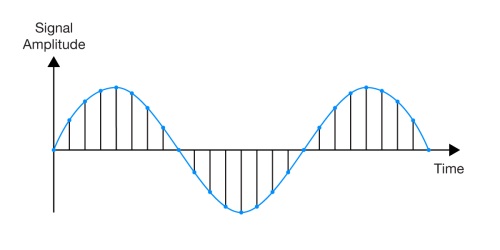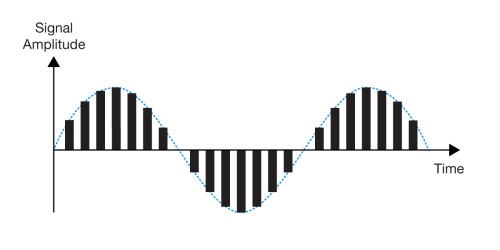By Mouser Electronics, www.mouser.com
Even though digital technology is creeping up the analog signal chain towards the source, analog signals will always be used in measuring real world analog data. An analog-to-digital converter (ADC) can be critical in moving analog data into digital processing, but you must examine the entire analog signal chain to get it right.
To get real-world, streaming data into a processor, you start with a transducer that changes physical data into an electrical signal. Next, a filter is used to eliminate signal noise with a frequency either too high or low for the anticipated operational range. The filter blocks signals with frequencies outside the expected bandwidth, eliminating extraneous noise before reaching the ADC.

An ADC takes periodic “snapshots” of data from the analog signal.
The ADC then samples and digitizes the analog signal. Sampling requires taking rapid instantaneous snapshots at regular intervals. After sampling, the signal is digital, changing everything about how the signal is handled. Matching an ADC to application requirements is critical for system accuracy. Once digitized, you cannot go back. Even though signal filtering may be accomplished solely by digital means, best practices in analog design still recommend analog filtering prior to the ADC. Filtering may still occur after digitization, although it’s a different type of filtering.
Another option is a programmable analog front end (AFE); an integrated chip that does the design work for you, if you are lucky enough to find an AFE that meets your analog design needs. AFEs exist for a large variety of applications. AFEs simplify the design process, save time, space, and cost, and can eliminate tasks such as checking error budgets.

The digitized data from ADC output approximates the analog signal by fitting the curve. An ADC with better resolution takes more samples (shown here as bars.)
Texas Instruments has several AFEs, including the new AFE4490 for Pulse Oximeters. It includes an amplifier, filter, 22-bit ADC, buffer, and controllable timing. The device completes control feedback loops to an external processor and is repurposed for photometry applications. Analog Devices’ ADAS3022 is a complete, 16-bit, 1 MPSP data acquisition system with a multiplexer, PGA, ADC, integrated reference voltage, and buffer. ADI has thoughtfully designed it to accept almost any direct sensor interface.

Ideally suited for pulse-oximeter applications, the AFE4490 is a complete AFE solution packaged in a single, compact QFN-40 package.
You cannot force an application to fit an AFE, but fortunately Mouser has many AFEs for a large variety of applications, such as ultrasound, powerline communication, pH sensors, copiers, energy measurement, motor control, battery management, and many more. AFEs are available for non-specific signal chains, too, such as an RF front end, inductive touch arrays, and full-duplex wideband communications. Many evaluation boards are marketed as AFEs. Come take a look at the newest AFEs at Mouser; you might find yourself saving a lot of time with your analog signal chain with one proven and tested AFE.
Advertisement
Learn more about Mouser Electronics





